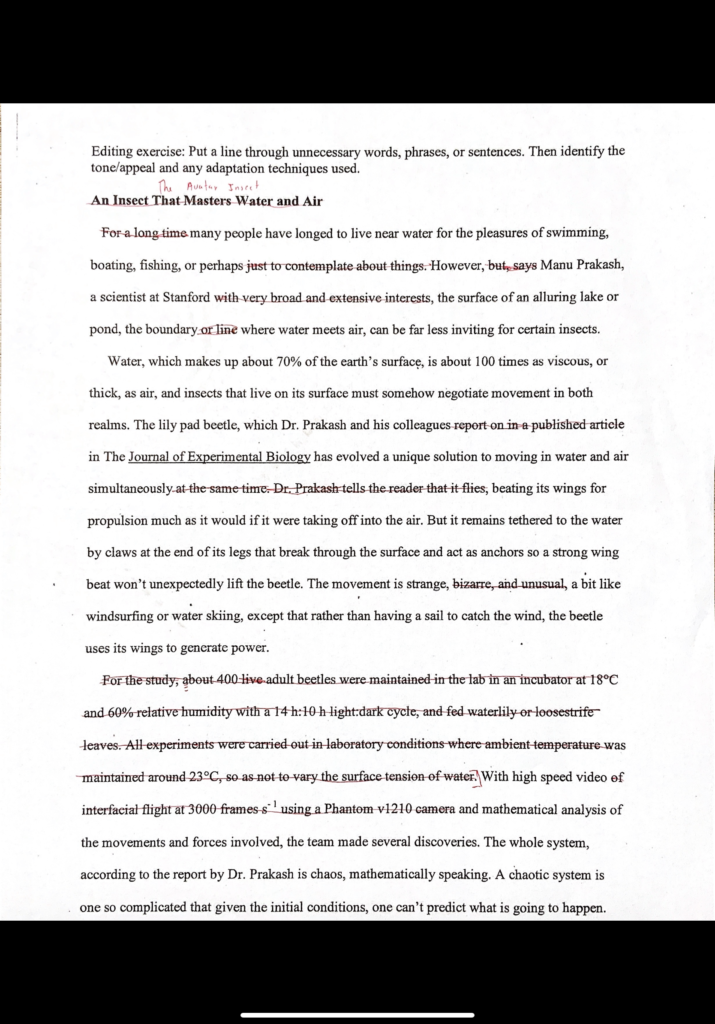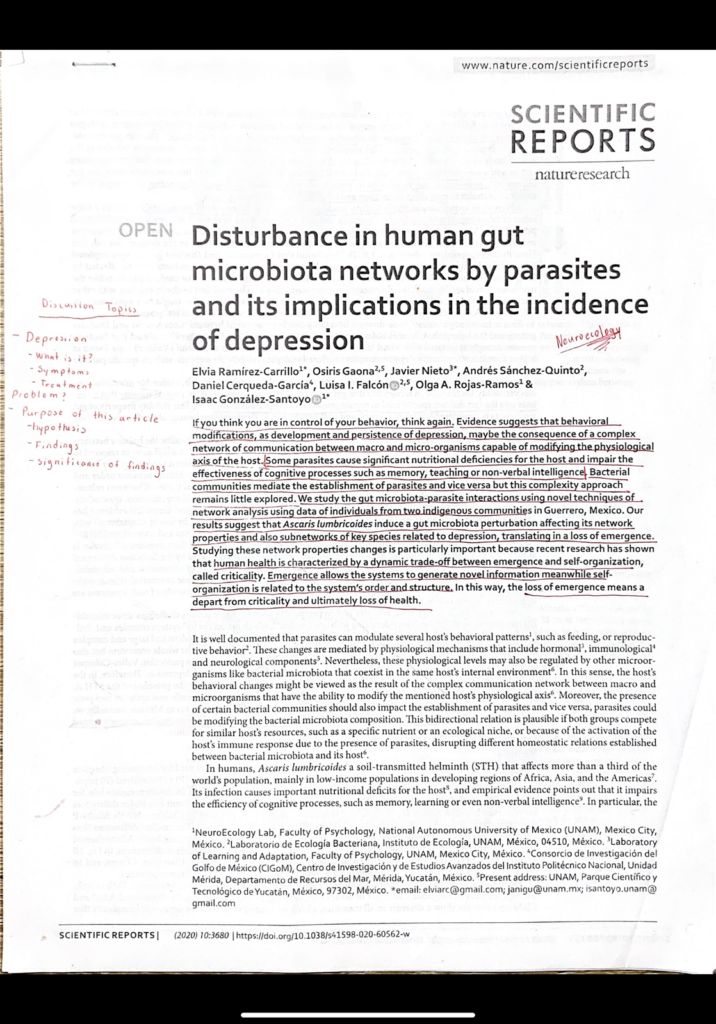Introduction
The purpose of this assignment was to write a paper modeled after general audience papers written in the New York Times. The paper that was used in order to write this assignment was a peer-reviewed, scholarly research article that followed the IMRAD format presented in Penrose and Katz. This assignment required that special attention be paid to tone, appeal, and audience expectations.Overall this assignment included an editing exercise, an annotated scientific article, a written out plan, a draft, peer reviews, a final paper, and a presentation based on the paper.
Worksheet

Annotations

Planning

First Draft

Peer Review

General Audience Paper
How Parasites could literally be sucking the happiness out of life
Depression is a common mood disorder that affects more than 250 million people worldwide. The symptoms of depression are severe and can affect cognitive and emotional functions such as sleeping, eating, and working. In order to be diagnosed with depression, the symptoms must be present for at least two weeks. The diagnosis can range from persistent depressive depression to postpartum depression. Once diagnosis occurs there are treatment options such as antidepressants and therapy. However, at least 75% of the people who are diagnosed with depression in low-income countries receive no care for their depression. This can be attributed to the stigma that surrounds mental health in those countries, misdiagnosis, and the lack of information that is available regarding the causes of the disease.
In the article titled “Disturbance in human gut microbiota networks by parasites and its implications in the incidence of depression” by Elvia Ramirez Carrillo, published in the journal Scientific Research, the possible involvement of parasitic activity in gut bacteria in the prevalence of depression is studied. Gut bacteria is vital in the regulation of our immune system, because of the large role it plays in digestion. To date, at least 50 human pathologies have been correlated to a change in gut microbiota. This is because the gut system has a two-way communication ability with the Central Nervous system (CNS). This connection allows our gut microbiota to be affected by certain things that the CNS controls. This includes emotional variables like stress or depression, with this in mind it is safe to assume that the gut microbiota can influence certain parts of the CNS. This influence would most likely be seen in the ability to become motivated and other cognitive functions. The reliance between the two networks greatly increases the importance of the gut microbiota system.
A parasite in this system would severely hinder the behavioral and cognitive patterns of the infected host. This study specifically focuses on the Ascaris lumbricoides parasite or the A lumb. A lumb is a soil-transmitted helminth that affects more than one-third of the world’s population. This parasite is mostly found in low-income populations in developing countries which includes but is not limited to regions in Asia, Africa, and the Americas. Infection with this parasite impairs cognitive processes, such as learning, non-verbal intelligence, and memory. It was found that A lumb. induces a gut microbiota perturbation which affects its network properties as well as subnetworks. This perturbation leads to a loss of what is known as emergence in the scientific community. Emergence is what allows the systems in the gut to generate novel information as well as self-organization. Losing emergence is equivalent to a loss of health.
The purpose of the article was to investigate how the gut microbiota that plays such a large role in our cognitive, as well as our emotional capabilities, impact depression. This study was conducted in two indigenous communities in Mexico called “Plan de Gatica” and “El Naranjo.” Mexico is home to at least 58 native groups whose ways greatly differ from the typical western style of living. These groups have no access to allopathic medications, no health system, and no water purification methods. This places these indigenous groups in the highest index of child and adult morbidity rates and the lowest access to health care. From the two groups that were selected for this study, samples were taken from 63 individuals. 34 of these people were adults while the other 29 were children. In order to measure the composition and abundance of the microbiota in the gut, fecal matter was tested from each individual. Two grams of fecal matter was taken from each individual and prepared to go through PCR amplification. Following the PCR Amplification, the 16S rRNA gene was sequenced in order to have digital data that could be entered into a computer for statistical analyses.
In order to determine whether or not the parasite was present in the microbiota the fecal matter was also analyzed. The “Mini-FLOATAC” protocol was used in order to identify STH in the matter. This was done through light field microscopy that focused on collecting sensitive quantitative results. The findings of the study indicated that the presence of the parasites in the gut could cause changes in the microbiota network strongly related to the incidence of depression. It was found that the A lumb parasite not only alters the function of the gut bacteria but it also hinders its interaction with other bacterial networks. The hindering of these networks means the hindering of communication with parts of the brain. This can include parts of the brain such as the amygdala, that is related to memory formation as well as memory storage. It can also play a big role in other parts of the brain such as the hypothalamus. Any change in this part of the brain can play a large role in the release of dopamine. And a lack of dopamine is one of the tell-tale signs of depression. Overall, the effects of the A lumb parasite on the gut microbiota has the potential to greatly impact the prevalence of depression.
It is important to understand the significance of a study such as this one. Depression is one of the least researched diseases in the world. This is mainly because it is categorized as a mental illness, though it oftentimes has physical manifestations. This study presented foundational steps in trying to find biological causes for depression. Knowing more about the biological causes of depression will make it much easier to treat. Even though one form of treatment does not work for all. Having a base would be extremely helpful in coming up with other treatments. Further research needs to be conducted in order to fully understand the extent of parasitic involvement in depression development. However, this study is an example of the steps that need to be taken in order to attack depression head-on.


